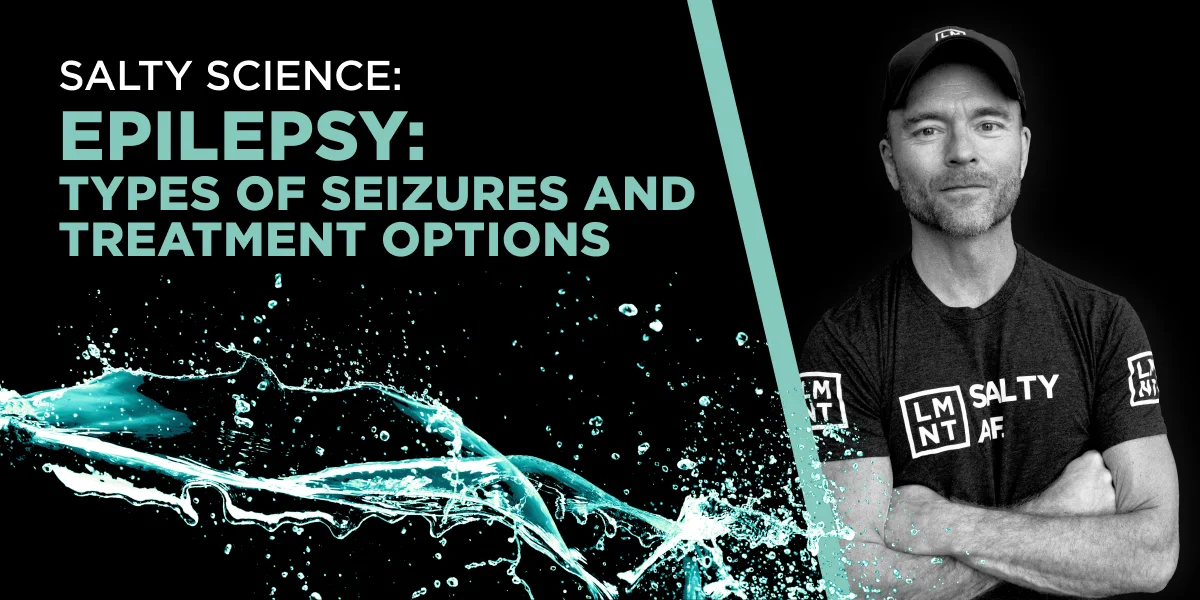
Epilepsy: Types of seizures and treatment options
From the desk of Robb Wolf
When someone is diagnosed with epilepsy, it’s important to identify what type of seizure they’re experiencing. Treatment options often involve trial and error, and diagnosing the seizure type can often point to which medicines may be most effective. If two medications fail to have a sustained impact, people are typically diagnosed with “refractory” (intractable) epilepsy, and are advised to consider surgical options.
People with epilepsy may also be advised to consider a ketogenic diet. Historically, doctors have viewed the keto diet as an improbable treatment for drug-resistant epilepsy, despite the fact the KD has oftentimes outperformed epilepsy drugs. Now, many forward-thinking scientists are urging practitioners to recommend carb restriction earlier in the treatment progression. And it doesn’t have to be the classic ketogenic diet of 90% fat and little else. Even a modified keto diet that allows for plenty of protein can often reduce the incidence of seizures.
Like with any condition, however, it’s rare that one treatment fits all. Some people who suffer from epilepsy will respond to keto, while others may experience better results with medication or—if all else fails—surgical procedures. In this article, I’ll cover the full spectrum of options. But before we cover treatments, let’s lay the groundwork for epilepsy and its different types of seizures.
Epilepsy 101
According to NIH StatPearls, epilepsy is “a condition of recurrent unprovoked seizures.” In this description, “recurrent” refers to two or more seizures occurring more than 24 hours apart. And “unprovoked” means the seizures are chronic and didn’t have an acute cause, such as drug withdrawal, traumatic brain injury, stroke, fever, or infection.
The most common cause of epilepsy in older folks is a group of conditions that affect blood flow and the blood vessels in the brain (cerebrovascular disease). In children, researchers often link genetic factors to increased seizure risk. But approximately 40% of epilepsy cases are idiopathic, which is a polite way of saying that we don’t know what’s going on.
It’s worth noting that epilepsy isn’t just one condition. It’s actually a group of disorders that includes Angelman syndrome, Dravet syndrome, infantile spasms, pyruvate dehydrogenase deficiency (PDHD), and many more. Recurrent unprovoked seizures, again, is what they all have in common.
Seizures 101
A seizure is a spontaneous electrical surge in the brain that causes temporary changes in consciousness, mood, memory, movement, or sensation. Essentially, a group of neurons (brain nerves) starts firing, triggering a cascade of excitability that ricochets throughout the nervous system. Precisely why these surges and cascades occur is still a mystery.
In the pursuit of answering these questions, scientists are researching chemicals called neurotransmitters that facilitate nervous system communication. Specifically, they’ve focused on GABA and glutamate. GABA is a relaxative (antiseizure) neurotransmitter, while glutamate is an excitatory (pro-seizure) neurotransmitter. When GABA and glutamate become unbalanced, a seizure can result. Many antiseizure medications (and even the ketogenic diet) are effective because—in one way or another—they have the potential to stabilize these neurotransmitters.
Types of Seizures
Classified by how they begin, there are three types of seizures: focal, generalized, and “unknown.” To aid in recognizing and classifying seizures (and to learn more about unknown onset seizures), I highly recommend checking out this fantastic resource from the International League Against Epilepsy.
#1: Focal Seizures
Focal seizures are the most common epileptic seizure, accounting for about two-thirds of incidents. They’re also called “partial seizures” because they start in one part of the brain. From there, they can spread to other brain regions, increasing the event’s severity throughout the body.
Focal seizures often begin with a vague sense of unease called an aura. Sometimes that’s it, but if the attack spreads, the person may experience shaking, stiffening, and disrupted awareness.
When a focal seizure disrupts awareness, it’s called a “focal unaware seizure.” If it doesn’t, it’s called a “focal aware seizure,” wherein the person knows what’s happening, but may still lose muscular control. The most severe focal seizures can develop into “tonic-clonic seizures,” which are characterized by blackouts and forceful shaking. More on those in just a moment.
#2: Generalized Seizures
Unlike focal seizures, generalized seizures (or generalized-onset seizures) involve electrical disturbances spread throughout the cerebral cortex and tend to be more severe. Some of these seizures begin outright, while others evolve from partial seizures. Here are a few subtypes within this broad category:
Tonic-clonic seizures (grand mal seizures)
Tonic-clonic seizures usually last 10–20 seconds, but unfortunately can continue for several minutes of unconsciousness and waves of violent full-body muscle contractions. If you’re with someone who has a tonic-clonic seizure, help the person to the floor and clear any potentially harmful objects from around them. Don’t try to restrain them, and please don’t put a wallet (or anything else) in their mouth as the old myth suggests—doing so can harm the teeth and gums. Most episodes resolve on their own, but if one lasts more than 5 minutes, call 911.
Myoclonic seizures
Myoclonic seizures occur most often in the morning and present with sudden jerking of the arms, head, or neck on both sides of the body. Children with juvenile absence epilepsy often suffer myoclonic and tonic-clonic seizures.
Tonic seizures
Tonic seizures are characterized by sudden body stiffness, and therefore often lead to falls and injury. Children with Lennox-Gastaut syndrome, a severe epilepsy disorder that typically develops before the age of four, will often experience tonic seizures.
Atonic seizures
Atonic seizures, or full-body limpness, often follow a tonic seizure, resulting in injuries and accidents. Atonic means “without tension.”
Absence seizures
Absence seizures, or petit mal seizures, are clinically marked by a short, sudden lapse in attention. Children typically outgrow childhood absence epilepsy, making it less common in adults.
Epilepsy and Seizure Treatment Options
Before deciding on treatment, the first step is to determine whether a seizure was actually a seizure. Many conditions (fainting, migraines, fever, low blood sugar, sleep disturbances, etc.) can mimic the appearance of seizures.
The next step is to determine whether the seizure was provoked or unprovoked. If it was provoked by alcohol withdrawal or drug use, the remedy is straightforward: titrate off the drug. But if the seizures were unprovoked and occurred at least twice, the person may have epilepsy. Along with reviewing a person’s seizure history, a medical professional will often perform a physical exam, take an electroencephalogram (EEG) to measure electrical activity in the brain, and require neuroimaging to triangulate the epilepsy disorder and better calibrate treatment. Drugs are generally the first option.
#1: Antiseizure drugs
A good anti-epilepsy regimen aims to eliminate seizures while minimizing the side effects of medication. “Antiepileptics,” or drugs that treat seizures by controlling abnormal electrical activity in the brain, fall into two main categories:
- Narrow spectrum. These drugs (carbamazepine, gabapentin, phenytoin, pregabalin, and others) work only for specific seizures.
- Broad spectrum. These drugs (clobazam, lacosamide, perampanel, primidone, zonisamide, and others) work against a range of focal and generalized seizures, including tonic-clonic seizures.
The newer antiepileptics tend to have fewer side effects than older medications, but finding the right drug often requires a trying period of experimentation.
#2: Surgery
Doctors may recommend various surgical procedures if the patient doesn’t respond to pharmaceuticals. The most common approach is to remove a piece of the cerebral cortex. Thankfully, this operation has recently become less invasive, thanks to MRI-guided technology.
Other surgical options include:
- Vagal nerve stimulation (sending electrical currents to the vagus nerve)
- Responsive neurostimulation (implementing a device that senses changes in a person’s body and responds with electrical neurostimulation)
- Thalamic stimulation (sending electrical currents to the thalamus)
- Corpus callosotomy (cutting the band of fibers that send seizure signals between the brain’s two halves)
However in most cases, it’s better to exhaust all other options before jumping straight into surgery—and I’ve got one more for you.
#3: Ketogenic diet
In the 1920s, Dr. Russell Wilder of the Mayo Clinic successfully used carb restriction to treat childhood epilepsy. He knew fasting reduced seizures, so he hypothesized that a fasting-mimicking diet could have anticonvulsant effects as well. And he was right.
Wilder called this low-carb, high-fat regimen the “ketogenic diet” because, like fasting, it facilitated the body’s production of backup energy molecules called ketones. And ketones, as subsequent research would reveal, have antiseizure properties. A keto diet may also reduce seizures by rebalancing GABA and glutamate, which you learned about earlier. While many of the mechanisms that make the ketogenic diet effective for epilepsy have yet to be explained wholly, there’s no doubt it can be effective.
Though Wilder used a traditional keto diet of about 90% fat, later studies showed comparable seizure reduction on a less-restrictive protocol—a modified version of the Atkins diet. I prefer the latter approach because it allows for a higher protein intake.
In Conclusion
I’m ending this article on the topic of keto in the hopes that it’ll stick in your brain. Of course, drugs and surgery have their place in epilepsy treatment, but some medical texts don’t even mention keto’s potential to reduce seizures. That’s why I wrote another article dedicated to the ketogenic diet for seizures. By ignoring nutrition outright, we’d miss out on one of our most accessible health factors. Epileptic seizures are complex—let’s pull out all the stops to prevent them.
